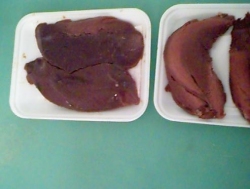
Photo 1 - Multicolored Ostrich Meat

Photo 1
shows a common problem in the Ostrich Meat Industry--multicolored meat.
The meat can vary greatly from very dark to light tan, sometimes even
light pink to almost white in color.
Multicolored Ostrich meat is caused by improper diets being fed to the
birds allowing significant inconsistencies from bird to bird and farm
to farm.
This sometimes causes consumers to object to Ostrich meat because of
the color as they are used to seeing a brighter red color meat from
other red meat livestock species. The multi-colored meat also has an
appearance of aged meat and not the fresh appearance the consumer is
looking for.
Using the Blue Mountain Ostrich Carcass Grading & Yield Systemę,
the meat shown in Photo 1 would clearly be graded as "UTILITY GRADE"
meat and should not be offered to our consumers as Filets or Steaks.
Photo 2 - Blue Mountain Ostrich Primary Muscles
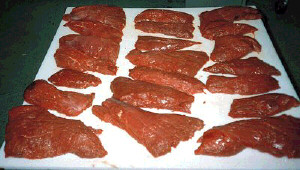
Photo 2
shows meat harvested from Blue Mountain fed birds. The meat is even
colored and bright red--much like the color of excellent beef.
There is no variation of color on the individual muscles and all muscles also are of even color from one to another.
This even and consistent bright red color is very acceptable to our
consumers. It has a very fresh appearance and a much longer shelf life.
Since Ostrich meat has no marbling of lighter colored fat mixed in the
meat, the bright red appearance makes it more desireable to the
consumer by giving it a wholesome and lean appearance.
Meat of this high consistency is brought about by excellent feeding
programs on the farm with balanced diets and feed containing proper
levels of all nutrients to promote the healthiest birds and the
healthiest meat possible.
Using the Blue Mountain Ostrich Carcass Grading & Yield Systemę,
the meat shown in Photo 2 would clearly be graded as "PRIME GRADE" meat
and is a high quality product to be offered to our consumers as Filets
or Steaks.
Photo 3 - Multicolored Ostrich Meat
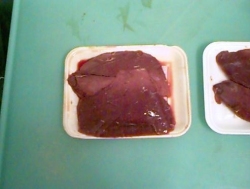
Photo 3
displays more of the multicoloring effect so often found in Ostrich
meat. You can see that the tips of these muscle cuts are nearly "Pink"
in color while the rest of the meat is of a brownish color.
Again, this symptom strongly indicates a nutritional deficiency in the
bird producing this meat. Correcting the diet and feeding program for
at least 6 months before processing the bird will usually correct the
multicolored meat symptom.
Another symptom of birds fed a poor diet is when the meat turns "black"
in spots or areas when exposed to the air. This indicates a lack of
antioxidants in the meat itself and is caused by certain nutrient
levels lacking in the feed.
Using the Blue Mountain Ostrich Carcass Grading & Yield Systemę,
the meat shown in Photo 3 would clearly be graded as "UTILITY GRADE"
meat and should not be offered to our consumers as Filets or Steaks.
Photo 4 - Blue Mountain Ostrich Portioned Filets
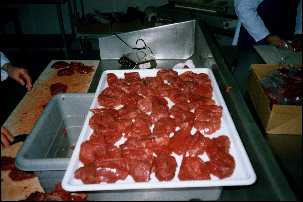
Photo 4
shows some Blue Mountain Ostrich Meat already portioned into filets and
ready for packaging. Notice the bright red color and how even the
coloring is from filet to filet.
Consumers really appreciate the Blue Mountain meat consistency as it is attractive to them.
Quality end products come from Quality birds. Quality birds come from Quality feeding programs.
Using the Blue Mountain Ostrich Carcass Grading & Yield Systemę,
the meat shown in Photo 4 would clearly be graded as "PRIME GRADE" meat
and is a high quality product to be offered to our consumers as Filets
or Steaks.
Photo 5 - Blue Mountain Ground Ostrich (Mince)
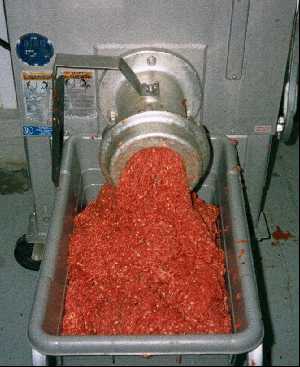
Photo 5
is what Blue Mountain Ostrich meat looks like immediately after
grinding the trim meat. Side by side, it is nearly impossible to tell
the difference between this meat and a very lean and high quality
ground beef.
The color is very bright red and most attractive. The Blue Mountain
Feeding programs are designed such that the meat will continue to turn
a brighter red when exposed to the air, for a period of time,
indicating a high level of antioxidants in the meat.
Healthy meat comes from Healthy birds that are fed a proper diet. All
Ostrich meat should look like this presentation for excellent consumer
acceptance.
Photo 6 - Blue Mountain Ground Ostrich (mince)
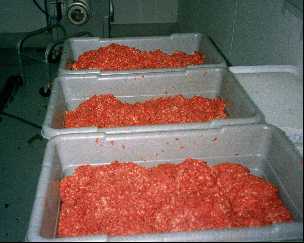
Photo 6
is more Blue Mountain Ground Ostrich meat that has been setting out in
a holding room for packaging at approximately 45 degrees F. for about 2
hours.
You can see that the color is consistent from tub to tub and batch to
batch. And, it is identical in color to the fresh ground Ostrich of
Photo 5.
Proper diet effects EVERYTHING Ostrich!
Copyright© of Blue Mountain all rights reserved